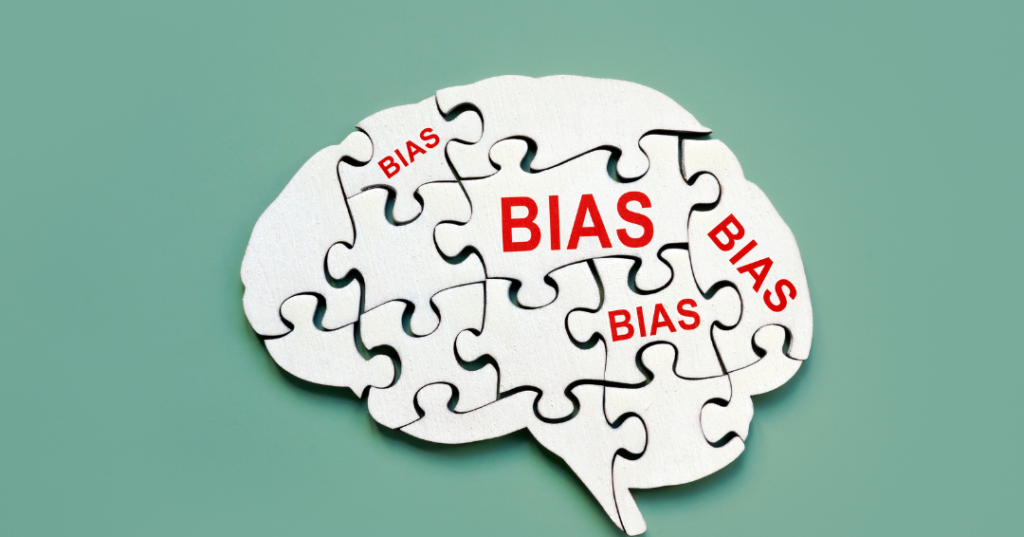Unconscious bias is still a pervasive issue in the modern workplace. Today, many hiring managers are prioritising/prioritizing diversity, equity, and inclusion in their hiring strategies. However, they’re still struggling to reach their goals due to the prevalence of hidden bias in the recruitment process.
In 2022, 57% of business leaders said diversity hiring was a priority for their talent acquisition strategy. After all, diverse teams make better decisions 66% of the time and are more likely to benefit from innovation and high productivity.
Despite this, 96% of recruiters still say unconscious bias is a significant problem for teams. Unconscious bias is extremely difficult to overcome. Humans are hard-wired to decide based on our moods, emotions, and past experiences.
Even if you believe your recruitment strategy is fair and equitable, there’s a good chance elements of unconscious bias are still seeping into your processes.
In today’s guide, we’ll discuss the science behind unconscious bias, how it works, and what business leaders can do to minimise/minimize its impact on their hiring decisions.

Understanding Unconscious Bias: An Introduction
So, what is unconscious bias?
Unconscious or “implicit” bias results from the automatic beliefs, prejudices, and associations that shape our decisions. It affects everyone, regardless of how accepting, open-minded, or inclusive they consider themselves to be.
The human brain is, unfortunately, built for unconscious bias. We’ve learned to make decisions quickly to protect ourselves from threats throughout the centuries. Our background, personal experiences, and education have guided these decisions.
It’s not just our associations with gender, ethnicity, and similar factors that can create unconscious bias in the workplace. Everything from a person’s name to height can trigger unconscious bias, influencing our behaviours towards others.
To understand unconscious bias, we must look closer at the human brain. In one experiment, researchers found that our brains use a different process for decision-making. The first system for decision-making is used for everyday, intuitive decisions.
For instance, you don’t spend hours deciding which route to take on your journey home; you automatically choose a direction based on your knowledge and past experiences.
The second system is used for complex, more important decisions, such as planning a work presentation or business trip. Though this second form of decision-making allows us to make more careful, informed choices, it’s also mentally taxing.
We can’t afford to use this decision-making process for everything we do, so we often automatically use the simpler decision-making system whenever possible. This is where unconscious bias comes from.
The Types of Unconscious Bias
When we think of unconscious bias in the IT channel, it’s easy to focus on negative forms of bias, like making decisions based on stereotypes linked to a person’s appearance or cultural background. However, there are many different forms of bias, such as:
- Perception bias: Probably the most common form of bias, perception bias is when we believe something is typical of a specific group based on stereotypes or assumptions. If all employees in a management role have previously been a certain age, we might assume that older candidates are more likely to be successful.
- Affinity bias: Affinity bias looks at our tendency to feel more positively about a person because they have similar characteristics to us. For instance, you might choose an employee from a similar background because you feel a stronger “gut” connection to them in the interview.
- Halo effect: This effect refers to when we project characteristics onto people we don’t know. For instance, you may prefer candidates who remind you of people you’ve had positive experiences with in the past.
- Confirmation bias: After making a snap judgment about a person, our brains are wired to look for ways to confirm our decisions. For instance, if you assume one person will be better suited for a particular role than another, you might confirm your assumption by highlighting previous experience in recent roles while ignoring evidence that your decision is incorrect.
- Attribution bias: With attribution bias, we assume the failures of others are based on their specific characteristics and experiences rather than looking at surrounding factors, such as the environment. Alternatively, we’re more likely to believe our failures result from issues outside our control.
Any biases could be triggered by glancing at a person’s CV/Resume in the hiring process. Even if you think it’s your intuition at work, your brain uses shortcuts to speed up your decision-making process.
How Unconscious Bias Affects Hiring Decisions
The hiring process gives employers and business leaders numerous opportunities to display unconscious bias.
We make snap judgements based on everything from a person’s age to gender and even their name. For instance, we might assume that a younger person is less likely to thrive in a senior management role because we associate age with experience.
External factors can also influence unconscious bias. For instance, how we feel, the time of day, and even the pressure we encounter to make decisions quickly can elevate unconscious bias.
Perhaps the biggest issue with unconscious bias is that it actively diminishes efforts to ensure inclusivity and diversity in an organisation/organization.
Studies reveal that 80% of employees want to work with diverse, equitable, and inclusive employers. Therefore, failure to implement diverse hiring practices can harm your employer brand and make attracting the right talent in a skill-short environment more difficult.
Additionally, a lack of diversity directly impacts your company’s chances of growth and success. Research shows that a diverse workforce improves your chances of making above-average profits by 43%. Different perspectives and backgrounds benefit businesses in every industry.
Recent Developments in Unconscious Bias
Demonstrating unconscious bias doesn’t necessarily make you a “bad person”. It’s a fundamentally human trait which we all share. Since our ancestors learned to make snap judgements to protect themselves against threats, we’ve shown unconscious bias.
However, for a few reasons, unconscious bias has become a more pervasive issue in the hiring landscape in recent years. Social media, technology, and access to endless information through the online world have given us plenty of content that confirms our unconscious biases and perspectives.
Additionally, while we’ve been relying more on technology to help minimise/minimize unconscious bias in the IT channel, recent innovations could be worsening the problem.
For instance, many companies now use ATS (Applicant Tracking Systems) and AI to streamline the recruitment process and filter through candidates. While these tools can help reduce bias, removing names and other details from applications can also show bias.
Many AI systems today are built on historical data, which is naturally biased. Cambridge University researchers found that most AI tools make decisions based on the information we have about previous employees. If your team members have fallen largely into specific categories for gender, age, and race, the system will prioritise/prioritize candidates with similar characteristics.
Amazon demonstrated how significant technology bias can be when they scrapped their AI-powered recruitment engine in 2018. The system was found to detect gender and negatively discriminate against female applicants.
Strategies for Mitigating Unconscious Bias in Recruiting and Hiring
While unconscious bias is natural, it’s also a significant problem in the recruitment industry. As mentioned above, unconscious bias harms your diversity, inclusion strategy, and employer brand. It demonstrates a preference for a specific “type” of candidate that can drive skilled professionals away from your thriving business.
Unconscious bias can impact your job descriptions, company decisions, and employees’ sentiments towards your brand. Around 60% of people now believe their workforce is biased, and 68% say this bias impacts their performance and productivity.
Ultimately, unconscious bias creates a workplace that’s lacking in diversity. Diversity across all aspects of the workforce is essential for connecting people who can contribute experiences and perspectives to your company.
This diversity fosters better problem-solving and innovation in the tech landscape and positively influences your bottom line. A study found that the more similar the leaders were in a company, the worse their organisation/organization performed.

So, how do you eliminate unconscious bias from the recruitment process?
1. Develop Awareness of Unconscious Bias
One of the reasons unconscious bias is so difficult to eliminate from the hiring landscape is that we don’t always realise/realize it’s affecting us. While many business leaders assume their hiring process is diverse, studies show that race, ethnicity, gender, and age biases are still plaguing the landscape.
The only way to eliminate this problem is for business leaders to be fully aware of how unconscious bias can affect their hiring, promotion, and succession decisions.
Training initiatives that teach business leaders to spot evidence of unconscious bias in their decisions can help with this. However, the key to success is consistently implementing training initiatives before hiring decisions are made.
Studies have found a reduced unconscious bias immediately after training sessions, but the effects wear off after around eight weeks. This suggests business leaders need access to comprehensive guidelines and tools that help them remember how to identify unconscious bias when making business choices.
2. Set Specific Diversity Goals
Setting clear goals for diversity, equity, and inclusion can be extremely useful in reducing unconscious bias in technology. They can help to ensure managers and business leaders remain focused on the issue of unconscious bias when making decisions.
Giving business leaders insights into the positive impact that diverse hiring can have on company morale, employer branding, and even profits can guide them towards making slower, more cautious choices.
Rather than encouraging hiring managers to fill roles as quickly as possible, ask them to concentrate on diversifying the company team. Look at your existing workforce and ask yourself whether you need to commit to increasing the number of women in your executive suite, the number of younger employees you hire, or the number of staff from different cultures.
Keep track of your results over time, creating diversity reports that look at how much progress you’ve made towards your DEI goals.
3. Use Technology Carefully
As mentioned above, technology can be a powerful tool in the recruitment process. Studies show that AI can help to reduce bias in the hiring strategy. It can remove personally identifying factors from candidate applications and help business leaders make objective decisions.
However, AI and automated tools can also further bake bias into recruitment processes. Tools that are trained on incomplete or biased data will drive negative results. This is why ensuring the tools you’re using are trained to minimise/minimize bias wherever possible is important.
It’s also why business leaders in the industry must avoid relying too heavily on technology when making hiring and succession decisions. AI can help companies filter through applicants, but an objective professional should always review the results.
For instance, a recruitment team can assist a company in sorting through applications with a focus on reaching specific diversity, equity, and inclusion goals.
4. Rework Job Descriptions
Unconscious bias is extremely common in job descriptions, not just in tech channel but everywhere. Even subtle word choices can impact how many actively apply for your roles. For instance, masculine language, such as adjectives like “competitive”, often leads to women believing they wouldn’t belong in a specific work environment. Alternatively, words like “collaborative” can draw in more women than men.
Carefully assessing your job descriptions for examples of biased language like “young go-getter”, “seasoned veteran”, or “lively professional” can help you reach more talent in a skills-short environment. Some tools can help with removing bias from your job descriptions.
AI solutions can assess your job descriptions, highlighting terms that might show a preference for a person from a specific age, gender, or cultural group. Additionally, professional sector recruitment agencies can use their experience to help you highlight potentially biased terms in your job ads and descriptions.
5. Rethink Your Application Review Process
It’s worth rethinking your application process since it’s often extremely difficult to ignore unconscious bias when deciding who to interview and eventually hire.
The key to success here is to focus on specific qualifications and talents instead of demographic characteristics. You can use technology or ask a recruitment agency to remove certain details from job applications, resumes/CVs, and cover letters.
Details like a person’s name or age don’t necessarily need to be included on a job application. Removing them completely will help your company focus on the things that matter, such as a person’s qualifications or experience in similar roles.
You could even consider using work sample tests to help narrow down your applicants. Work sample tests mimic the tasks a candidate will do on the job and help indicate whether they’re suitable for a specific role.
Ask your candidates to solve work-related problems in their application or participate in a skill test that examines specific abilities.
6. Standardize the Interview Process
Research demonstrates that unstructured interviews, which lack pre-defined questions examining experience and expertise, are unreliable for predicting job success. In an unstructured interview, hiring managers have more scope to ask unique questions that can help confirm their existing biases.
Rather than constantly evaluating candidates based on the same factors so you can make an educated, objective decision, you may adjust your questions to help validate existing assumptions. Standardizing interviews with structured questions helps to minimise/minimize bias by ensuring you’re always evaluating candidates based on the same strategy.
You could consider using interview scorecards to grade candidate responses to certain questions on a pre-determined scale.
- Work with a Recruitment/Search Company/Partner
One of the easiest ways to reduce unconscious bias in recruitment is to work with a specialist IT Channel / Technology recruitment/search company www.ice-recruitment.com
We can eliminate bias in a variety of different ways. First, we give employers access to a wider talent pool. Because we understand the challenges of bias, we take additional steps to reduce the problem when looking for candidates for your team.
We assist you in writing job descriptions that don’t show preferences for specific candidates and offer help with blind recruitment strategies.
We can also help you optimise/optimize the candidate experience and onboarding process to ensure every candidate you bring into your team gets the same level of support, elevating your employer brand.
8. Implement Ongoing Diversity Initiatives
Finally, it’s worth remembering that eliminating unconscious bias isn’t just crucial during the initial recruitment and hiring process. Creating truly diverse teams and delivering on your diversity, equity, and inclusion initiatives requires an ongoing strategy.
Business leaders must ensure they deliver the same opportunities to every employee, regardless of their gender, age, background, or other surface-level factors. This means executive teams must work together to create succession and development plans that keep unconscious bias out of the workforce long term.
Providing employees and managers with ongoing training to eliminate bias and creating an environment where every employee gets the same recognition and opportunities for growth will lead to the development of a more inclusive company culture.
This will help strengthen your employer brand to attract more staff members to your team. Plus, it will be crucial to preserving the engagement of your existing employees, improving retention and minimising/minimizing turnover.
Eliminate Bias From Your Recruitment Strategy
In a world where employees demand diversity, equity, and inclusion from employers, unconscious bias is a problem that can’t be overlooked. Business leaders can’t afford to make decisions that harm the diversity of their teams and stifle innovation.
Additionally, as skill shortages continue to grow, organisations/organizations must reduce bias to consistently access the talent they need.
Reducing unconscious bias isn’t simple. It requires business leaders to completely rework their decisions and be mindful of their thought processes. However, with an active approach, using the steps above, and the right recruitment agency, it is possible to minimise/minimize unconscious bias and its negative impact on your team.



